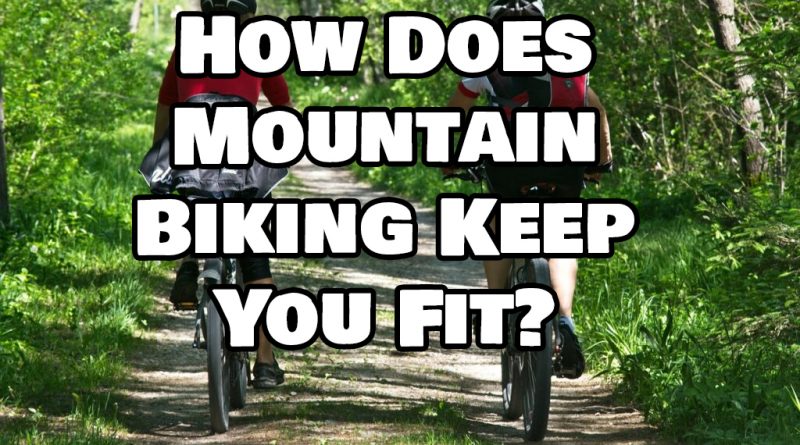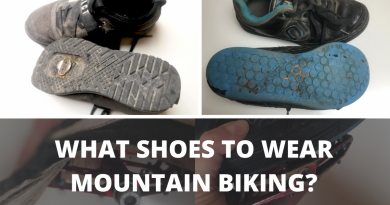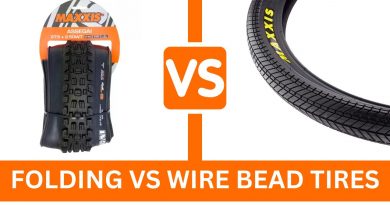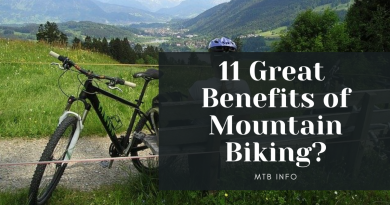How Does Mountain Biking Keep You Fit? (Answered)
- How Does Mountain Biking Keep You Fit?
- What Muscles Does Riding A Mountain Bike Work?
- How Many Calories Does Mountain Biking Burn?
- What Factors Determine How Many Calories are burned?
- How Many Calories Does a 3 Hour Aggressive Mountain Biking Ride Burn?
- What Does Mountain Biking Do To Your Body?
- Is Biking Good For Your Core?
- Will Biking Build Leg Muscle?
- Will Mountain Biking Get me in Shape?
- Is Riding a Mountain Bike Good Exercise?
- How to get the perfect Pedal Stroke? (For Full Muscle Activation)
How Does Mountain Biking Keep You Fit?
Mountain biking keeps you fit by working with different muscles in different ways. When cycling, you will find that at least some of your muscles are working at all times, and over the course of a full ride, you will find that you have used most major muscle groups.
What Muscles Does Riding A Mountain Bike Work?
Mountain biking uses a large number of muscle groups, including the core muscles, quads, calf muscles, buttocks, hamstrings, shoulders, chest, arms, and forearms. In fact, it really does offer a full-body workout. It uses more muscles than regular road biking due to the nature of the sport.
Lower-Body Muscles:
- Quadriceps and calf muscles are used in pedaling.
- Hamstrings work with the calf muscles to pull the leg up.
- The buttock muscles move the thigh and help with balance along with the abdominal muscles.
Upper-Body Muscles:
- Biceps help with stabilization and moving the handlebars.
- Triceps and pectoral muscles help with stability from ground vibrations and when descending.
- Forearms are used for gripping as well as braking and shifting gears.
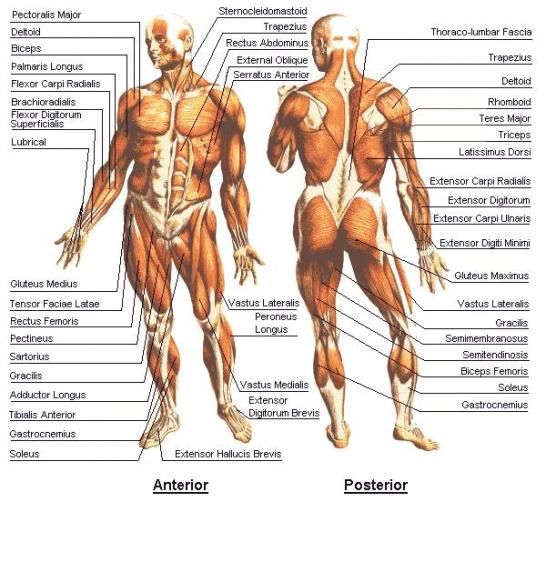
How Many Calories Does Mountain Biking Burn?
This is a complicated question as there are a number of different disciplines in mountain biking, and people ride at different levels, but generally speaking, mountain biking burns between 200 and 1400 calories an hour. This is obviously a very wide range, but there are ways that the overall calories can be calculated when taking into account the different factors that come into play.
What Factors Determine How Many Calories are burned?
There are a number of different factors to consider that affect the number of calories burned. These are:
- Intensity of riding
- Altitude
- Suspension
- Tire diameter
- Wheel width
- Posture on the bike
- Aerodynamic drag
- Rolling resistance
- Gender
- Rider’s weight
- Kind of terrain being ridden
- Tread pattern
- Wind
- Gradients
- Weight of the bike
- Tire pressure
- Whether the rider is using clipless pedals
How Many Calories Does a 3 Hour Aggressive Mountain Biking Ride Burn?
While it is hard to determine precisely how many calories a 3-hour aggressive ride would burn, it can be between 3,000 and 4,500 calories if the rider is really riding flat-out.
What Does Mountain Biking Do To Your Body?
Mountain biking is, generally, very good for the body. As well as being great cardio exercise, there are also a number of different benefits. These are:
- Full body workout. All types of cycling give the calf muscles a good workout, and all cyclists have strong legs and thighs. However, mountain biking actually gives the entire body a good workout. Balancing, as well as climbing and turning, helps strengthen the upper body.
- Better sleep. By tiring yourself out riding you improve the regenerative sleep that you get at night. Riding also decreases cortisol – a hormone that can keep you awake at night. Exposing yourself to daylight also helps the body maintain its natural circadian rhythm, which is vital for healthy sleep patterns, as well as increasing the body’s production of vitamin D.
- Benefits of nature. Research has found that being out in nature helps to reduce stress and aids relaxation when compared to being in an urban environment.
- Improved balance. The brain, muscles, and nervous system all work together when mountain biking to help improve balance and coordination. Balancing on a bike helps to build muscle memory and strengthens neural pathways, benefits that might not be immediately obvious.
- Brainpower. Cycling increases blood flow to the part of the brain that forms memories. Researchers have also found that a 5% increase in cardiac-respiratory fitness from cycling led to an improvement of as much as 15% in mental tests.
- Reduced stress on the joints. Mountain biking is low impact compared to exercises such as running. It is also a non-load bearing sport meaning it takes pressure off the joints.
- Improved heart health. Cycling for at least 20 miles a week can reduce the risk of heart disease by as much as 50%. Mountain biking uses the large muscle groups and they require a lot of oxygen. This makes the heart work at a steady rate and can increase heart health by between 3% and 7%.
- Less risk of disease. Regular exercise helps to strengthen the body’s immune system. Research has shown that people who cycle for half an hour, five days per week take half as many sick days from work as people who don’t. Other research has shown that women who cycle – even if it’s only cycling to and from work – have a reduced incidence of breast cancer.
- Reduced stress. Mountain biking causes the body to release endorphins which help improve mood and reduce stress. It also helps to boost serotonin which helps to reduce depression and anxiety. This, added with improved sleep patterns, all help to add up to better mental health.
Is Biking Good For Your Core?
Mountain biking is very good for the core. The abs and the core are used to help keep you stabilized. It might not feel as though the core is working out as much as some other muscle groups, but in reality, any sport that involves motion with your legs will also work the core. The core muscles include the pelvic floor muscles, transversus abdominis, multifidus internal and external obliques, rectus abdominis and erector spinae, especially the longissimus thoracis and the diaphragm.
Will Biking Build Leg Muscle?
Biking is very good for building leg muscle. Pedaling uses virtually all of the leg muscles at one point or another during the pedaling cycle. The pedaling cycle can be broken down into a number of different phases. These are as follows:
Propulsive phase: During this phase of the pedaling cycle the following muscles are used:
- Gluteus Maximums
- Hamstrings
- Vastus Lateralis
- Vastus medialis
- Soleus
Recovery phase: During this phase of the pedaling cycle the following muscles are used:
- Iliopsoas – this muscle group is comprised of the iliacus and psoas muscles.
Both phases: During both phases of the pedaling cycle the following muscles are used:
- Gastrocnemius
- Rectus Femoris
- Tibialis anterior
With all of these muscles at work, it’s clear to see that cycling is an excellent way to build leg muscle. This is why cyclists always have strong leg muscles.
Will Mountain Biking Get me in Shape?
Mountain biking is a superb way to get in shape. Of course, it isn’t as simple as just getting on a bike and going for a ride. Other factors, such as diet, also play an important part.
Is Riding a Mountain Bike Good Exercise?
Mountain biking is very good exercise. Vigorous mountain biking can burn over 1000 calories an hour, making it a great way to exercise. As well as working as a good cardio workout, it also helps strengthen the lower body, as well as giving the core and the upper body a workout as well. This means that, unlike road cycling, it is a full-body workout. It is just about the best possible cardio exercise that you can do, and being low impact also helps to build up your legs without any risk of damaging the joints.
Does Wheel Size Affect Muscle Activation?
There is little difference between muscle activation with different wheel sizes. The larger-sized wheels make pedaling easier, but in practice, there is not much in the way of variation between the different wheel sizes. However, greater muscle activity in the biceps has been noticed when descending on 26-inch wheel bikes. This could be due to an increased need to maneuver the front wheel over obstacles.
How to get the perfect Pedal Stroke? (For Full Muscle Activation)
Proper ankling is one of the keys to perfecting the pedal stroke. There are a number of factors to take into consideration.
- Hip-knee-ankle alignment: Looking from the front, the hip, knee, and ankle of the rider should line up throughout the pedal stroke. It should be like a piston firing up and down.
- Saddle position: If your saddle is too low, then you’ll end up with knee pain. If it’s too high, then you won’t be able to pedal effectively.
- Dropping the heel: Dropping the heel in the power phase of the downstroke – from about 12 O’clock to 5 O’clock – helps to extend the hip.
- Initiate the downstroke early: One mistake that a lot of riders make is not initiating the downstroke early enough. Many riders wait till they are at 3 O’clock to initiate the downstroke but, in fact, it should be initiated before 12 O’clock.
- Reaching peak power earlier: A major difference between pro cyclists and amateur cyclists is the point at which they reach peak power. A pro cyclist will reach peak power at about 110 degrees, whereas an amateur cyclist will usually reach peak power at between 120 degrees and 130 degrees.
The muscles that are used for pedaling can be split into three main categories. These are as follows:
- Drive (power): Gluteals, quadriceps, and gastrocnemius.
- Draw (recovery): Tibialis anterior, hamstrings, and hip flexors.
- Stabilizers: Abdominals, erector spinae.
You may also want to check out:

